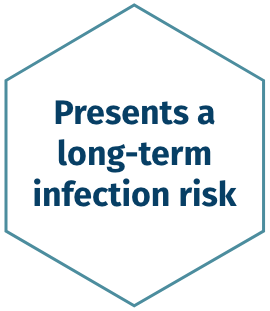The challenges of coccidiosis in poultry
Coccidiosis is a constant and costly threat to the poultry industry, shown to significantly and negatively impact broiler chicken production.

> Different parasite species = peaks at different bird ages
> Late outbreaks can occur due to poor immunity

> A ubiquitous parasite
> Can survive in the environment for long periods2

> Broiler feed conversion rate (FCR): up to 10%3
> Weight gain: up to 7%3
> Intestinal Integrity (I2) scores4
> Mortality5
> Disease rates6-9
The impact of poor poultry coccidiosis control
costs up to £125.5 million in the UK and
£13 billion per annum worldwide10
Coccidiosis in poultry alone costs 4p per bird due to the negative impact on Intestinal Integrity, including broiler feed conversion ratios. Its association with necrotic enteritis increases this to 7.8p per bird11,12
Don’t let coccidiosis negatively impact your broiler flock
Monitoring bird Intestinal Integrity (I2) scores via HTSi makes sure that coccidiosis in
birds is not quietly impacting the productivity of a flock over time.
Learn how to control coccidiosis in broilers
- McDougald, L. 2003. “Parasitic Diseases: Coccidiosis.” Diseases of Poultry. 11th ed.:974-985
- López-Osorio S, et al. (2020) Overview of Poultry Eimeria Life Cycle and Host-Parasite Interactions. Front. Vet. Sci., 03 July. Sec. Veterinary Infectious Diseases
- Marusich, W. et al. (1972). “Effect of coccidiosis on pigmentation in broilers.” Br. Poultry. Sci. 13:577-585
- Elanco HTSi data (2022)
- Watkins KL, et al. (2017). Observational analysis of broiler production and health data collected during the transition to a raised without antibiotic program. Poult. Sci. 96 (Suppl. 1)
- Lanckriet A, et al. (2010). The effect of commonly used anticoccidials and antibiotics in a subclinical necrotic enteritis model. Avian Pathol. Feb;39(1):63-8
- Clave H et al Sciences et Techniques Avicoles 2004
- Ruff, MD, et al. (1980) Anticoccidial activity of Narasin in broiler chickens reared in floor pens. Poultry Sci; 59:2008-2013
- HTSi Data EMEA region 2010-2016
- Blake DP et al. (2020). Re-calculating the cost of coccidiosis in chickens
- Kadykalo, S. “The value of anticoccidials for sustainable global poultry production.” 2017. International Journal of Antimicrobial Agents. 1-7
- Williams, R. 1999. “A compartmentalized model for the estimation of the cost of coccidiosis to the World’s chicken production industry”. Int Journ.for Parasitoloty. 29(8):1209-1229